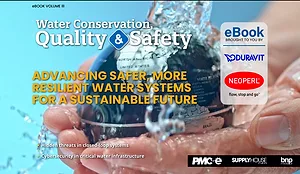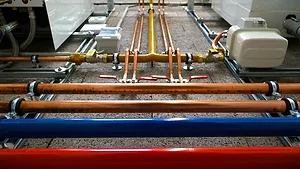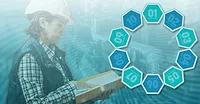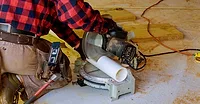2025 Plumbing Industry Outlook
December 6, 2024
2025 Plumbing Industry Outlook
December 6, 2024Looking ahead into 2025, there are reasons for plumbing and HVAC contractors to be optimistic. Image source: Photovs / iStock / Getty Images Plus
The past year was one of both opportunity and adaptation for plumbing and HVAC contractors. While rising interest rates and inflation led to tighter budgets for some customers, contractors saw demand for energy-efficient systems and water conservation technologies, driven by incentives and regulations promoting sustainability. Heat pumps, low-flow fixtures and leak detection systems gained traction in both residential and commercial markets.
Extreme weather events like Hurricanes Helene and Milton heightened the need for repairs, retrofits and disaster-proof installations. These events also highlighted gaps in preparedness, prompting contractors to expand emergency response capabilities as well as revisited the issue of resilient, adaptable infrastructure across the country.
Labor shortages persisted, challenging contractors to find skilled workers. Many firms invested in upskilling current staff, apprenticeships, and initiatives like reverse mentoring to bridge generational knowledge gaps.
And, looking ahead to 2025, there are reasons to be optimistic.
“We see that consumers’ fiscal position getting better as we go through the end of this year and even better as we go deeper into 2025,” notes Brian Beaulieu, consulting principal and chief economist for ITR Economics. Beaulieu presented a keynote address to plumbing and HVAC contractors at Nexstar Network’s Super Meeting, which was held in late September. “We really think the second half of the year is going to be better than the first half of the year. How's it going to impact our industry? It's going to help our industry. We're already getting some upside signals from the ITR remodeling leading indicator. Permits are showing some strength. Existing home sales are still weak, but there are some early signs of that turning around. So all those are good precursors for business getting better the further we get into 2025.”

Despite the assumed recession for the broader U.S. economy in 2024 and into 2025, FMI anticipates engineering and construction spending will continue to expand, albeit at a slower rate over its forecast period, according to its Fourth Quarter Engineering & Construction Outlook. Image courtesy of REHAU
Beaulieu explains there will be the typical seasonal slow months experienced at the beginning of the year.
“That’s not going to feel great,” he says. “The key there is what are you doing to do between now and then to differentiate yourself? Get involved with social media — that’s been a big theme of this conference. Being on social media and using artificial intelligence (AI) to help with efficiencies.”
In terms of demand shifts between residential and commercial sectors, NIBCO President and CEO Ashley Martin notes a significant emphasis on commercial growth in 2025, particularly in data centers, which continue to be a major area of expansion.
“Within the commercial space, we’re also seeing strong growth projections in healthcare facilities and hospitals, where demand remains robust nationwide,” she says. “The education sector is also performing well, and we anticipate sustained demand in this area. These three segments — data centers, healthcare, and education — are where we expect to see the most growth in the coming year. In the residential sector, while there remains a strong demand for housing across many markets, high interest rates are likely to temper growth compared to previous years.”
Simon Koenig, director of plumbing and infrastructure at REHAU, expects repair and remodeling in the plumbing industry to increase in 2025.
“The ongoing housing shortage, paired with the fact that the average home in the U.S. is now more than 40 years old, will prompt homeowners to address problems in their current homes,” he says. “Many will choose to invest in improvements that not only maintain but also add value to their homes with upgrades, ensuring they remain functional and in prime condition for many more years to come.”
Looking for a reprint of this article?
From high-res PDFs to custom plaques, order your copy today!

Education spending is forecasted to remain stable through 2028, according to FMI's Fourth Quarter Engineering & Construction Outlook. IRA funds will be used to begin projects into 2025, largely focused on HVAC, lighting, building envelope, clean and renewable energy solutions, and car-charging stations, the report states. Image courtesy of REHAU
Koenig says there will be an increase in both residential and commercial sectors in 2025, but the demands for each will be different.
“For residential plumbers, repair and remodeling as I mentioned earlier will be a large subset in this category,” he says. “While housing starts have started to tick upwards, the demand in residential plumbing truly lies in homeowner’s need to repair the conditions in their current homes. Commercial plumbers will face growing demand to retrofit older buildings with sustainable, modern plumbing systems that enhance energy and water efficiency, while also ensuring compliance with current building codes and regulations.”
KEY MARKET TRENDS
According to Dan Callies, president of Oak Creek, Wisconsin-based Oak Creek Plumbing and president of PHCC — National Association, sustainability and tech will rule the day in the coming year.
“Think smart toilets that can almost run your house, water-saving fixtures and eco-friendly systems,” he explains. “Energy efficiency regulations are tightening up, so contractors will need to innovate or risk getting left in the dust.”
Callies agrees that renovations will still be booming in 2025, but now with a “save the planet” twist.
“Homeowners want energy-efficient, eco-friendly systems that look good, too,” he says. “Commercial clients will push for more green compliance. Emergency calls — well, thanks to smart leak detectors, fewer people will wait until their house is half underwater before calling us!”
He adds that contractors also shouldn’t sleep on 3D printing or prefabrication components, as they could save serious time and effort.

Manufacturing was up 21% in 2024 over 2023, according to FMI's report, and is forecasted to increase another 5% in 2025. For the plumbing and HVAC industries, manufacturers have begun to onshore or reshore production to protect supply chains after struggling with disruptions these past few years. Image courtesy of NIBCO
Jamie Gerdsen, chief people officer of TurnPoint Services, and a member of the board of directors of Nexstar Network, notes that AI is really the tip of the iceberg for contractors.
“AI in 2025 is like, ‘Do you have email,’ in 1996,” he says. “The real question is, ‘What's the real level of technology you want to integrate?’ And ‘What is technology that's cool, but does not add value?’ Contractors who do a really good job of navigating and executing in that arena are actually willing to learn fast. That’s the evolution — let’s learn really fast, let’s put stuff into play. People forget the fundamentals are still in play. It’s not AI, it’s augmentation. That’s what AI does.”
Martin agrees that AI will undoubtedly remain one of the most significant trends shaping the plumbing industry moving into the next year.
“From wholesalers and distributors to contractors, everyone can harness AI to optimize their business operations,” she explains. “Applications range from streamlining blog posts and job listings to enhancing customer service. Every company, regardless of its role in the industry, stands to benefit from the efficiencies and insights AI provides. As more businesses adopt AI, data management and the growth of data centers will also become a critical trend. Emphasis on data security is particularly relevant for companies like NIBCO, which is currently testing AI internally to ensure it can leverage these technologies while safeguarding its data.”
WATER CONSERVATION AND SUSTAINABILITY
Water conservation and smart water management will also play an increasingly significant role in 2025, according to Mark Croce, senior product manager at PVI and Andrew Macaluso, senior product manager at Lync, both Watts Water Technologies brands.
“Software and platforms that provide real-time data and analytics can help optimize boiler and water heating equipment performance, making it easier to monitor efficiency, anticipate maintenance needs and reduce energy consumption,” Croce says. “Facility staff are increasingly looking for — and expecting — tools like this to make informed decisions to drive cost savings and operational efficiency.”
"Water conservation will continue to be a significant focus, with growing interest in systems designed for water reuse and rainwater capture,” Macaluso adds. “At Lync, we see increased demand for these technologies, particularly in new building designs. This trend toward sustainable water management is becoming a key part of the design process for both residential and commercial buildings, reflecting a trend of broader commitment to conservation and resource efficiency in the plumbing industry.”
The big question in the plumbing and HVAC industry moving into 2025 is still about how best to decarbonize, Macaluso explains. “It’s not necessarily about converting directly to electric but more about improving existing systems. It's not just about replacing a gas-fired plant with a heat pump. It's also about exploring gains from tuning equipment, improving operational efficiency or implementing better reset schedules. People are searching for solutions in every corner right now.”



The single-family residential market was up 5% this year over 2023 and is forecasted to increase another 5% in 2025, per FMI. This segment is expected to benefit from the recent onset of a rate-cutting cycle along with some anticipated political support in addressing affordability concerns and limitations. Due to declining interest rates, homebuilders plan to more regularly compete with existing homeowners’ listings through the end of this year and into 2025. Builders will remain competitive against traditional lending on existing homes over the near term, FMI reports. Images courtesy of REHAU
Nery Hernandez, senior product manager at AERCO, another Watts brand, notes there is a growing trend toward hybrid boiler systems that combine electric and fossil fuel options.
“For instance, our new Benchmark E electric boilers are frequently combined with gas-fired Benchmark models,” he explains. “This approach is gaining traction because it offers building owners flexibility in managing energy sources, mitigating the impact of energy price fluctuations, and diversifying risks. Hybrid systems are also being recognized as a cost-effective solution for meeting stricter local regulations around building decarbonization. Facilities can reduce their carbon footprint while still maintaining reliable, efficient heating.”
Natural gas and electricity are not the only options for homeowners and building owners when it comes to sustainability either. There are 13 million homes across the country using propane right now, according to Tucker Perkins, CEO of the Propane Education & Research Council.
“The affordability of electricity is being called into question right now,” he says. “The electric prices that I'm seeing are up 30% over the last four years. Some places have seen 10% to 15% increases in the last year. And I don't think it's going to go backward for quite some time, as electric utilities grapple with renewable power data centers, EV charging and all of that stuff. We'll see that propane continues to be well regarded, but even used more and more and more moving forward.”
Earlier this year, Perkins hosted a panel discussion with construction experts live from the 2024 Southern Living Idea House, a 4,400-square-foot South Carolina property, complete with high-end appliances, a pool, and a guest home, that utilizes propane for key home systems and appliances. The virtual roundtable explored propane’s role in construction, sustainability and home resiliency.
The home reduces CO2 equivalent emissions by 13% compared to an all-electric home. Propane is a low-carbon alternative fuel that produces 52% fewer greenhouse gas emissions than the equivalent amount of the U.S. grid electricity. Current rates show a $264 per year savings on the home’s energy bill for just water heating (assuming 5 people live in the home), according to PERC.
NEW TECHNOLOGIES TO WATCH
According to Koenig, smart technology is making its way into plumbing tools and products. “Things like leak detectors, automatic water shut-offs and water tracking technology are useful for both homeowners and plumbers. These new technologies can help homeowners save money, conserve water and can help diagnose potential problems sooner.”
Macaluso points to controls and remote monitoring becoming increasingly prominent.
“We're seeing a shift where it's no longer a high-end or luxury feature — it's the norm,” he says. “People expect their plumbing equipment and systems to offer remote access, data collection and analysis. Users want insights into system efficiency, energy usage over time and predictive maintenance alerts. With the rise of apps and more user-friendly interfaces, the expectation is that equipment can be remotely viewed and managed, with onboard data collection included. This shift toward smarter, more connected systems is where the market is headed.”


The 2024 Southern Living Idea House is a 4,400-square-foot South Carolina property, complete with high-end appliances, a pool, and a guest home, that utilizes propane for key home systems and appliances. The home reduces CO2 equivalent emissions by 13% compared to an all-electric home. Images courtesy of PERC

Current rates of the Southern Living Idea House show a $264 per year savings on the home’s energy bill for just water heating (assuming 5 people live in the home), according to PERC. Residential and commercial customers will be looking for greener solutions in 2025 to meet changing energy regulations and save money on utilities. Image courtesy of PERC
Martin points to several emerging plumbing innovations poised to gain significance in 2025, particularly in high-performance valves and press technology.
“Press technology is an area where we anticipate continued growth,” she says. “The result is a cost-effective solution that delivers consistent joint quality, reducing callbacks and enhancing job site productivity. PressACR, in particular, offers a faster, more reliable installation process for the refrigeration and air conditioning sectors. The demand for refrigeration is increasing, and with it, the need for quicker, more efficient installations. PressACR addresses these demands by enabling fast, flame-free joinery, which is both safer for users and minimizes the skill level required for installation —an advantage in an industry experiencing a skilled labor shortage.”
POSSIBLE CHALLENGES ON THE HORIZON
The labor shortage remains a top challenge for everyone — contractors, engineers, manufacturers and wholesalers — heading into the new year.
“The skilled labor shortage is no secret,” Koenig says. “We need to focus on youth outreach at the high school level to send the message to the next generation that this industry is just as important as doctors and lawyers to help propel our society forward. We also need to continue to foster apprenticeship and continuing education programs for young professionals who recently entered the trade workforce.”
Martin agrees that the persistent labor shortage will impact all segments of all the trades. “This shortage affects wholesalers, contractors and overall project timelines, and the issue is expected to continue into the foreseeable future. To adapt, the industry must focus on integrating more automation at every stage, from manufacturing to distribution, allowing companies to maintain efficiency even with fewer workers.
“For contractors, new technologies, such as press and push fittings, are streamlining processes and reducing time on-site, though it doesn’t eliminate the need for actual skilled workers,” she continues. “With industry research showing that for every five plumbers retiring, only one enters the apprenticeship program, the pipeline for future skilled workers continues to be a concern. This imbalance underscores the urgency of investing in both automation and training initiatives to sustain a workforce capable of supporting future growth in the plumbing and heating industry.


Along with skilled labor, rising material costs and supply chain delays will continue to challenge contracting businesses. “Contractors should focus on training, automating where possible, and learning to do more with less,” says PHCC's Dan Callies. Images courtesy of REHAU
Callies notes that along with skilled labor, rising material costs and supply chain delays will continue to challenge contracting businesses. “Contractors should focus on training, automating where possible, and learning to do more with less.”
Beaulieu also points to material costs as possible challenges for plumbing and HVAC contractors in the near future.
“The Producer Price Index is starting to rise again, and that’s the raw material side of the price indexes,” he explains. “We're also seeing copper remaining quite high relative to, say, aluminum, and that's because of the electrification of everything, so contractors are going to have to be able to pass these price increases through as part of their pricing model. They've already gotten a good lesson in being able to do that on the other side of the pandemic, but back then, the demand was swamping the industry, so it was a lot easier to pass through those price increases. Now they're going to have to be a lot more finessed in making that happen, but they have to do it.”
Croce adds that supply chain concerns remain top-of-mind.
“The impact of COVID was obvious,” he says. “Recently, we’ve seen port strikes, which highlights the risks of relying heavily on overseas production. Producing in the U.S. has become a real advantage for PVI because of challenges like these. Also, there are stricter regulations that often require American-made products, especially in government contracts. These changes also bring pricing implications, as domestic production generally carries higher material and labor costs. However, the increased stability and compliance with U.S. standards may offset these costs by providing a more reliable supply chain.”

New technologies, such as press and push fittings, are streamlining processes and reducing time on-site, though it doesn’t eliminate the need for actual skilled workers, notes NIBCO's Ashley Martin. Image courtesy of NIBCO
The supply chain can also face unanticipated challenges such as weather disruptions or potential labor strikes, Martin points out.
“Unforeseen weather events, which can happen at any time, can cause sudden material shortages,” she says. “Unexpected events, like the recent port strikes, can slow down product availability across all industries, not just in plumbing, resulting in longer lead times and increased shipping costs. One way NIBCO mitigates these risks is through its commitment to U.S. manufacturing. With 90% of our products made domestically, we can maintain more stable availability compared to some of our competitors that rely heavily on overseas manufacturing. This localized production helps us reduce dependence on international supply chains, positioning us to deliver products faster and with fewer disruptions.”
Additionally, the preparation for stricter energy efficiency standards will be a significant challenge in 2025, according to Croce. “PVI is addressing this challenge by producing cost-effective, high-efficiency products and providing detailed guidance on their installation as well as training resources. We’ve recently opened a state-of-the-art training facility at our factory in Fort Worth, Texas, where we offer a wealth of courses in addition to our online learning opportunities.”
Widely varying state-specific water quality system certifications are also presenting a challenge to contractors, Macaluso adds. “They can be confusing and hard to navigate. As more states introduce unique mandates, contractors will need to know which certifications apply in each location, as non-compliance can prevent system installations. To help address this, Lync is developing clear, accessible guidance on certification requirements for each state and providing resources to help contractors stay informed on regulatory changes.”
RISING COMPETITION
The consolidation of the plumbing and HVAC services market through private equity buyouts has also presented a concern for family-owned businesses and their ability to compete. Beaulieu warns this trend will continue because “PE firms have a lot of money and there are demographics at play — some folks just don’t have anybody to hand or sell the business to and they’re ready to retire and get out.”

Controls and remote monitoring are becoming an increasingly popular trend as we head into 2025. Image courtesy of PERC
Gerdsen is in a unique position of seeing things from both hemispheres. After growing up in a family business, he bought the company from his father, then ended up partnering with TurnPoint in November 2020.
“The way we would differentiate ourselves as a small business is by creating a concierge-level experience to create a career, not a job,” Gerdsen says. “Our theme was, ‘Hey, we would like to teach you about the trade, and then make sure you have enough resources so if a spouse or partner wants to stay home to raise the kids, you can do that.’ Competitively speaking, small businesses have much more opportunity to do that than they give themselves credit for. At a large scale, one of the biggest challenges today for TurnPoint is we forget the fundamentals.
“If I were a contractor today, I would focus on making the most of the opportunity you have,” he adds. “That means you need to look at things like your conversion rate? How are you handling inbound phone calls? What's the customer experience like? And go back to the fundamentals of serving the customer better than your competition. No. 2, you have to serve your employees. How does the employee show up to work? How does that employee feel about work? Is the employee be successful at work? Then, the final one is you have to look for new opportunities, whether it's adding additional trades, adding geography or maximizing your partnerships with vendors and other people that you use.”

Training and upskilling employees will continue to be key for plumbing and HVAC contractors to remain competitive in the 2025 market. Image courtesy of REHAU
Callies advises that personalized service is a contractor’s secret weapon. “Build relationships with your customers, know them by name, and provide that extra level of attention. Focus on a niche, whether it’s high-end homes or green plumbing, and market yourself like a pro.”
Training and upskilling employees will continue to be key for plumbing and HVAC contractors to remain competitive in the 2025 market.
“Training is key,” Callies notes. “Smart systems, green solutions, and digital tools are the future. Learning these skills now will save you and your employees from being the last person who doesn’t know how to install a smart faucet. Nobody wants to be *that* plumber.”
ADVICE FOR 2025
Martin’s advice to plumbing and HVAC contracting businesses looking to thrive in 2025 is to take advantage of technology!
“Whether that is technology in products like press and push fittings that help with projects or by using AI in their daily businesses to help recruit people, advertise and market their businesses,” she says. “In addition to leveraging technology to make them more efficient, we also recommend that they reinvest in their people to retain and train their employees for future growth. This is something that we are particularly proud of at NIBCO. We believe the key to our success is the rich heritage of our people who we refer to as associates because they are owners of the company. We have had employee ownership since 1924. As we celebrate our 120th anniversary this year, we are incredibly grateful for the dedication and commitment of our associates and recognize the pivotal role they play in driving our success.”
Callies advises contractors to be adaptable in 2025.
“Embrace change, invest in your team, and stay focused on quality service,” he says. “Build relationships with customers, and remember: water flows downhill, payday’s on Friday, and always laugh when you can — it helps when you’re knee-deep in a crawl space!
“Plumbing can be tough, but it’s rewarding, too,” Callies adds. “Keep learning, have a little fun along the way, and don’t forget to enjoy the ride. After all, laughter is the best tool in the box — right next to the pipe wrench!”
Videos courtesy of Nicole Krawcke/Plumbing & Mechanical.










